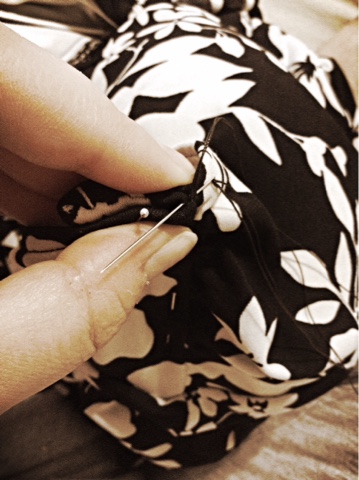Since my experiment of adding paint to fabric with my Gelli Plate, I have been wondering if there was any other unconventional way to add color to fabric. I remember batiking in high school, and thought why not dye fabric with crayons. Being a mom and an artist/art teacher, we have accumulated a lot of crayons. My kids have a whole shoe box full of crayons. Most of which are broken with the paper torn off. Perfect for this little experiment!
Supplies needed:
Crayons
Pan
Freezer paper
Muslin
Extra Cotton Fabric
Iron
Ironing Board
Paper Bags
Tongs
Gloves
Scissors (Might Be Handy)
I got down a pan to get started, and went through their box of crayons. I picked out colors in the same color family while adding in a little while. Once I found what I was looking for, I placed them in the pan.
I then put the pan on the stove, and turned it on to medium heat. The waiting time begins.🕐
I could see the crayons starting to melt, so I gave it a little stir with my plastic fork.
While the crayons melted, I got my freezer paper ready. I laid the paper on the stove next to my pan with the shiny side-up. This would allow me to have something close by to lay out my fabric once it was time to take it out of the melted crayons.
When the crayons were melted, I added a piece of muslin cotton into the pan. I stirred the fabric around with my plastic fork. This would be a great time to use those gloves and tongs, both of which I didn't have. Try not to slosh the fabric around in the hot wax. You will get burned! True story.
Keep moving the fabric gently until all of the melted wax has covered the fabric. I didn't realize that my plastic fork would melt. Thank goodness for trial and error.
I removed my fabrics with two forks. This is where metal tongs would have come in handy again because this is going to be HOT! You make do with what you have.
Let dry, which won't take long. I had enough left to dye one more piece of fabric. I repeated the process and laid it out to dry on another piece of freezer paper. After using up all the wax, make sure to wash your pan right away while it's still melted with hot water. This will make cleanup a lot easier.
 |
| Dyed Fabric Piece #1 |
 |
| Dyed Fabric Piece #2 |
When the fabric was dry, I took it to the iron. All of the wax has to be ironed out, or you will have one stiff, crunchy piece of fabric. I grabbed a larger piece of cotton, and sandwiched the wax fabric in between the cotton.
I turned my iron on making sure it was a dry iron. There shouldn't be any water in the reservoir.
Place the iron on the fabric and press until you see the wax appear onto the cotton fabric.
Make sure to move the cotton fabric around, so that you are always ironing onto clean, wax free fabric. You don't want to iron the wax back into the muslin.
When I moved the cotton fabric around, I noticed I was dyeing my ironing board cover. Whoops!
When I finished the first dyed muslin, I moved on to the second dyed muslin. I switched to a green fabric this time to release the wax.
Repeat the process of releasing the wax.
When I was finished with the green cotton, I noticed some awesome texture! Why not get another dyed piece of fabric out of it. This time I sandwiched the cotton between a cut up paper bag. This worked a lot better than using the cotton fabric.
Place the iron onto the paper bag. Move iron around until you see the wax coming through. This might take a little longer to see because the paper bag is thicker than the cotton fabric. Keep going until the paper bag doesn't show anymore wax.
So excited to get four pieces of fabric, two dyed pieces and two printed pieces!
 |
| Dyed Fabric Piece #1 |
 |
| Dyed Fabric Piece #2 |
 |
| Printed Dyed Fabric Piece #1 |
 |
| Printed Dyed Fabric Piece #2 |
Once again I have learned a lot from this DIY. Fabric can be dyed from crayons, and it kind of gives it a tie dyed effect. Just make sure you have the right supplies before you get started. Paper bags work better than cotton fabric in soaking up the wax from each dyed piece. Now I'm not sure what I'm going to do with these pieces, but I surely got some interesting texture out of each. What unique processes have you found to dye fabric with?

























































